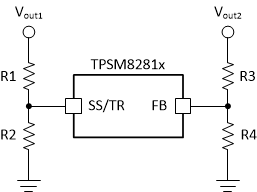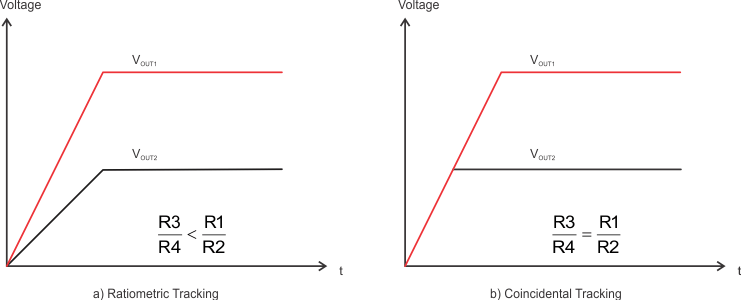JAJSI06B September 2019 – July 2024 TPSM82810 , TPSM82813
PRODMIX
- 1
- 1 特長
- 2 アプリケーション
- 3 概要
- 4 Device Comparison Table
- 5 Pin Configuration and Functions
- 6 Specifications
- 7 Parameter Measurement Information
- 8 Detailed Description
- 9 Application and Implementation
- 10Device and Documentation Support
- 11Revision History
- 12Mechanical, Packaging, and Orderable Information
9.3.1 Voltage Tracking
The SS/TR pin is externally driven by another voltage source to achieve output voltage tracking. The application circuit is shown in Figure 10-21. From 0V to 0.6V, the internal reference voltage to the internal error amplifier follows the SS/TR pin voltage. When the SS/TR pin voltage is above 0.6V, the voltage tracking is disabled and the FB pin voltage is regulated at 0.6V. The device achieves ratiometric or coincidental (simultaneous) output tracking, as shown in Figure 10-22.
The R2 value must be set properly to achieve accurate voltage tracking by taking the 2.5μA charging current into account. 1kΩ or smaller is a sufficient value for R2. For decreasing SS/TR pin voltage, the device does not sink current from the output when the device is in PFM mode. The resulting decrease of the output voltage can be slower than the SS/TR pin voltage if the load is light. When driving the SS/TR pin with an external voltage, do not exceed the voltage rating of the SS/TR pin which is VIN+0.3V.
 Figure 9-29 Schematic for Output Voltage Tracking
Figure 9-29 Schematic for Output Voltage Tracking Figure 9-30 Output Voltage Tracking
Figure 9-30 Output Voltage Tracking